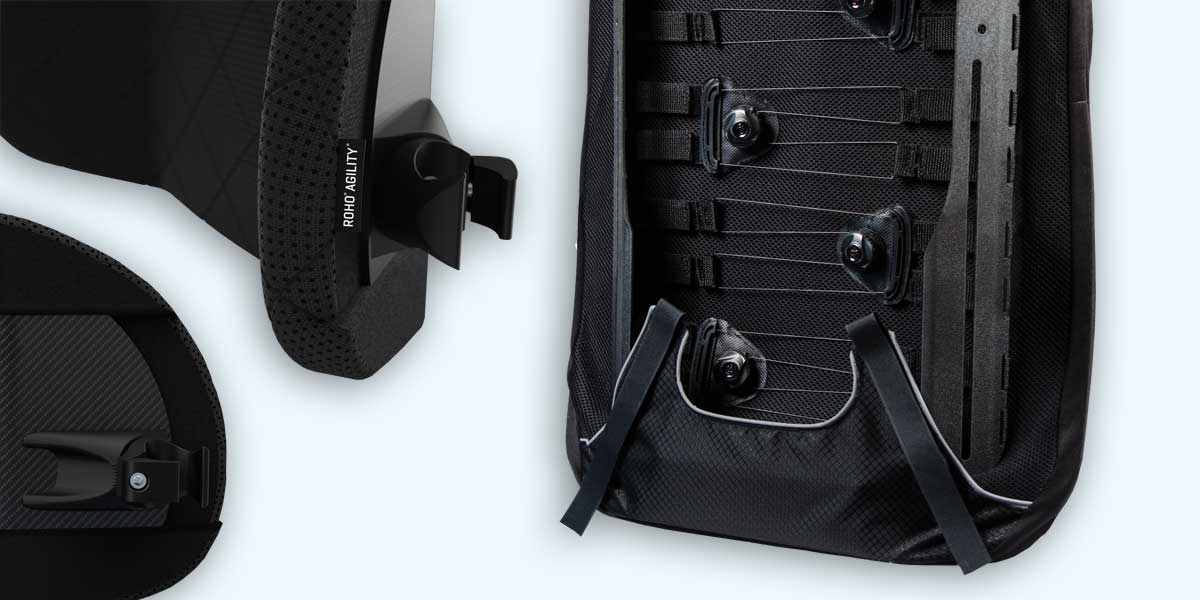Looking for more information on seating and positioning? Check out Permobil seating and positioning page here.
Back supports, commonly referred to as ‘back rests’ for a wheelchair, don’t typically receive a lot of attention. A back support for a wheelchair should be referred to as a 'support' rather than a 'back rest' because it provides essential spinal alignment and postural stability, which are crucial for health and comfort. The term 'support' emphasizes its active role in maintaining proper posture and enhancing mobility, whereas 'rest' implies a passive function.
Adjustable to accommodate different body shapes and sizes, some back supports can also have head supports and lateral trunk supports attached to them. We’ll discuss these important positioning accessories in our next blog, but for now, let’s get back to the backs!
The goal of selecting an optimal back support is to promote proper spinal alignment and reduce the risk of developing pressure injuries or discomfort while using your wheelchair.
Three things to consider when making your selection…
- It allows for optimal contact of your body with the support surface
- It provides even pressure distribution along the spine
- It helps reduce shear forces (two forces moving against each other) by maximizing the stability of the spine, and as a result, the pelvis, to prevent unwanted movements in your wheelchair
Back supports are typically made from a combination of durable and lightweight materials such as molded aluminum, foam, air cells, and breathable fabrics. Let’s look at each of these components next:
Molded aluminum or carbon fiber back shell
Back supports are often crafted from moldable aluminum or carbon fiber, materials known for their lightweight yet sturdy properties. (Did you know we have more info on how these materials are used in manual wheelchair frames too?) These materials allow for custom shaping or contouring to provide optimal spinal alignment and personalized comfort, ensuring both durability and effective support for the user.

There are also unique features that can be offered within a back shell as well. Comfort's Acta-Back with aluminum stays and the Acta-Relief with the BOA™ dial system both provide exceptional support and customization, but they cater to different needs and preferences.
 Customization: Features moldable aluminum stays that can be manually adjusted to fit the unique contours of the user's spine, offering a high degree of personalized support.
Customization: Features moldable aluminum stays that can be manually adjusted to fit the unique contours of the user's spine, offering a high degree of personalized support.
Support: Provides robust and stable support, ideal for users who need significant postural alignment and stability.
Adjustment: Requires manual adjustments by a caregiver or clinician to mold the aluminum stays to the desired shape.
Acta-Relief with BOA Dial System
 Customization: Utilizes the BOA dial system, allowing for precise and easy adjustments by simply turning a dial to achieve the desired level of support.
Customization: Utilizes the BOA dial system, allowing for precise and easy adjustments by simply turning a dial to achieve the desired level of support.
Support: Offers dynamic and adaptable support, making it suitable for users who require frequent changes in their back support throughout the day.
Adjustment: Provides quick and convenient adjustments that can be made independently by the user without the need for tools or assistance.
Both systems offer high levels of customization, but the aluminum stays provide a more fixed support once adjusted, while the BOA dial system allows for continuous and easy adjustments. The BOA dial system is more user-friendly for individuals who need to adjust their support frequently and independently, whereas the aluminum stays require a more hands-on approach. The aluminum stays provide a very stable and secure support, ideal for users who need consistent and strong postural alignment, while the BOA system offers flexibility and adaptability for varying support needs. Choosing between the two depends on your specific requirements for stability, ease of adjustment, and the level of independence desired in managing your back support.
Foam
Back supports offer a variety of foam options to cater to your different comfort and support needs. Memory foam conforms to the body's shape, providing personalized comfort and pressure relief. High-Density foam offers firm support and durability, ideal for long-term use. Gel-Infused foam combines the support of foam with cooling gel to assist with temperature regulation and enhance comfort. Contour-cut foam features specialized cuts and shapes to improve posture and provide targeted support. Each foam type has unique benefits, allowing you to select the best option for their specific requirements and preferences.
Air Cells
Some back supports incorporate air cells within their design. ROHO's technology uses interconnected air cells to provide dynamic, adaptive support that conforms to your body shape. This assists with even pressure distribution and reduces the risk of skin breakdown, enhancing overall comfort and spinal alignment. The ROHO AGILITY Max Contour back system is the only deep back that features independent adjustable lateral air pads, in addition to air cells placed along the center of your spine!

Fabrics
There are many options when you consider your preference for a fabric on the back support. Mesh fabrics allow air circulation, helping to reduce heat buildup and assist with temperature control. Durable fabrics made of materials such as nylon or polyester are often easy to clean and maintain, but may feel warmer after prolonged sitting.
Want to learn more about how to choose which back support may be the best for your seating and positioning Solution? Head over to our Solutions for every Body landing page and come back for our final part of this blog series where we discuss positioning accessories for your mobility device.
 Nicole LaBerge, PT, ATP
Nicole LaBerge, PT, ATPCommercial Product Manager - Permobil Americas
Nicole B. LaBerge, PT, ATP is a Physical Therapist with 18 years of experience in a variety of clinical settings. She currently works for Permobil as a Commercial Product Manager of Seating and Positioning products. Her past clinical practice has included seating and mobility for adult and pediatric populations, with a focus in neurological rehabilitation, power standing and wound care. Nicole has presented at the State and International Levels, has multiple publications in peer reviewed journals and enjoys sharing her passion for patient advocacy, efficiency, and clinical outcomes. She served as an Executive Board Member for the Clinician Task Force for 3 years and is currently an active member in the CTF.

